
Daviesia horrida, commonly known as prickly bitter-pea, is a species of flowering plant in the family Fabaceae and is endemic to the south-west of Western Australia. It is a spreading shrub with rigid, spiny branchlets, narrowly elliptic phyllodes and orange and dark red flowers.

Daviesia brevifolia, commonly known as leafless bitter-pea, is a species of flowering plant in the family Fabaceae and is endemic to the southern continental Australia. It is a broom-like shrub with short, cylindrical phyllodes and apricot to reddish-brown flowers.

Daviesia ulicifolia, commonly known as gorse bitter-pea, is a species of flowering plant in the family Fabaceae and is endemic to south-eastern Australia. It is a rigid, openly-branched shrub with sharply-pointed, narrow elliptic, narrow egg-shaped, rarely egg-shaped phyllodes and usually orange-yellow and dark red flowers.
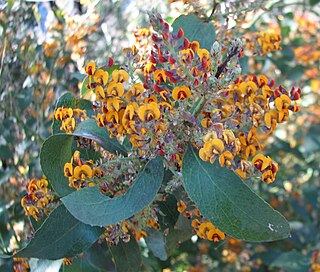
Daviesia latifolia, commonly known as hop bitter-pea, is a species of flowering plant in the family Fabaceae and is endemic to south-eastern Australia. It is a slender, erect, spreading shrub with elliptic, egg-shaped or lance-shaped phyllodes and orange-yellow and maroon flowers in long racemes.
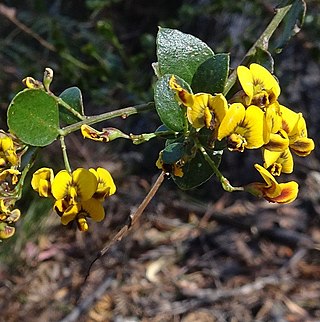
Daviesia buxifolia, commonly known as box-leaf bitter-pea, is a species of flowering plant in the family Fabaceae and is endemic to south-eastern continental Australia. It is an open shrub with egg-shaped to round phyllodes and yellow or yellowish-orange and maroon-brown flowers.

Daviesia mimosoides, commonly known as blunt-leaf bitter-pea, narrow-leaf bitter pea or leafy bitter-pea, is a species of flowering plant in the family Fabaceae and is endemic to eastern continental Australia. It is an open shrub with tapering, linear, elliptic or egg-shaped phyllodes, and groups of orange-yellow and dark brownish-red to maroon flowers.

Daviesia wyattiana, commonly known as long-leaf bitter-pea, is a species of flowering plant in the family Fabaceae and is endemic to eastern Australia. It is a sparse, erect shrub with long, linear phyllodes, and groups of four to seven yellow flowers with red or purplish markings.

Daviesia arborea, commonly known as golden pea or bitterleaf pea, is a species of flowering plant in the family Fabaceae and is endemic to eastern Australia. It is a shrub or small tree with weeping branches, linear phyllodes and yellow flowers with red markings.

Daviesia arenaria, commonly known as sandhill bitter-pea, is a species of flowering plant in the family Fabaceae and is endemic to south-eastern continental Australia. It is usually a hummock-forming shrub with many short, spiny branchlets and heart-shaped to elliptic phyllodes with a sharp point on the end, and orange-pink, maroon and yellow flowers.
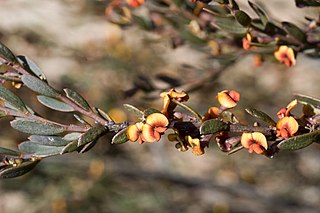
Daviesia argillacea is a species of flowering plant in the family Fabaceae and is endemic to the south-west of Western Australia. It is an erect, bushy shrub with erect narrow egg-shaped phyllodes with the narrower end towards the base, and yellow to orange and maroon flowers.
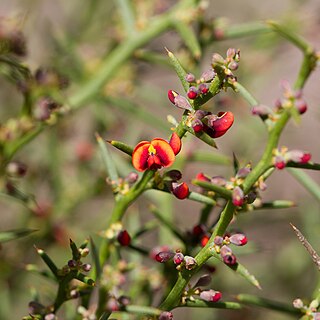
Daviesia devito is a species of flowering plant in the family Fabaceae, endemic to south-eastern continental Australia. It is a dense, prickly shrub with sharply-pointed phyllodes and yellow, red, greenish and maroon flowers. It was previously known as Daviesia benthamii subsp. humilis until that subspecies was split into two new species.
Daviesia eremaea is a species of flowering plant in the family Fabaceae and is endemic to central Australia. It is an erect, glabrous, multi-stemmed shrub with needle-like, more or less sharply-pointed phyllodes, and yellow and red flowers.

Daviesia genistifolia, commonly known as broom bitter-pea, is a species of flowering plant in the family Fabaceae and is endemic to south-eastern continental Australia. It is a glabrous, low to open shrub with scattered, sharply-pointed, cylindrical phyllodes and yellow or orange-yellow, deep red and maroon flowers.
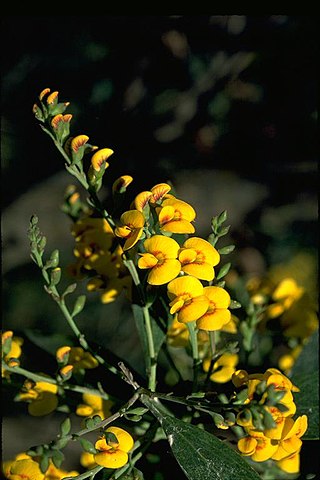
Daviesia laxiflora is a species of flowering plant in the family Fabaceae and is endemic to eastern Victoria, Australia. It is a large shrub or small tree with drooping branches, linear to narrow elliptic phyllodes and long racemes of mostly bright yellow flowers.
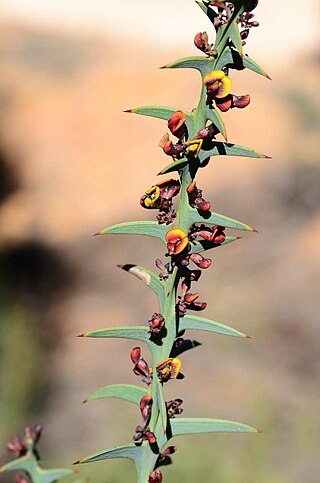
Daviesia pectinata, commonly known as thorny bitter-pea, is a species of flowering plant in the family Fabaceae and is endemic to south-eastern continental Australia. It is a dense, rigid shrub with erect, flattened branchlets, crowded, flattened, triangular phyllodes, and yellow to orange and reddish flowers.

Daviesia pedunculata is a species of flowering plant in the family Fabaceae and is endemic to south-western Western Australia. It is a spreading or sprawling to erect shrub with erect, egg-shaped to elliptic phyllodes, and yellow and maroon flowers.

Daviesia physodes is a species of flowering plant in the family Fabaceae and is endemic to near-coastal areas of south-western Western Australia. It is an open shrub with vertically flattened or tapering, sharply-pointed phyllodes, and yellow and pink to red flowers.

Daviesia reclinata is a species of flowering plant in the family Fabaceae and is endemic to northern Australia. It is a prostrate or straggling shrub with scattered linear phyllodes, and yellow flowers.
Daviesia scoparia is a species of flowering plant in the family Fabaceae and is endemic to the south-west of Western Australia. It is a broom-like, glabrous, leafless shrub with yellow, dark reddish-brown and maroon flowers.

Daviesia villifera is a species of flowering plant in the family Fabaceae and is endemic to eastern Australia. It is a hairy shrub with arching branches, sharply-pointed egg-shaped to heart-shaped phyllodes, and yellow and dark red flowers.


















